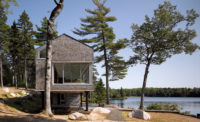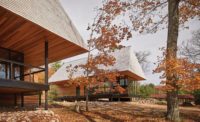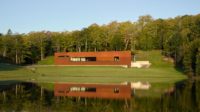MacKay-Lyons Sweetapple Architects Make Their Mark on Halifax's Waterfront
Nova Scotia

Architects & Firms
It all started with a 2010 radio interview. “Architecture can express our culture’s highest aspirations—whether it’s a house or an important public building,” architect Brian MacKay-Lyons told CBC host Don Connolly. That profound sense of optimism was exactly what Scott Armour McCrea, who happened to be listening, wanted in a designer for a new 450,000-square-foot mixed-use development in Halifax, Nova Scotia. With four Record Houses in his portfolio, the founder of the firm MacKay-Lyons Sweetapple Architects is best known for deft residential work informed by the area’s vernacular barns and fishing shacks. But in his office’s downtown neighborhood in the same city, far from glacial drumlins and craggy shorelines, he turned to a very different maritime lexicon that is deeply intertwined with Nova Scotia’s identity.
Queen’s Marque, as the project is called, occupies a sizable downtown blockfront along Halifax Harbour that is highly charged with technological, mercantile, and maritime history. To the north is George Street, a civic axis that terminates on one end with the Old Town Clock and, on the other, the Cable Wharf, built in 1913 to receive transatlantic messages from undersea cables. To the south is Prince Street and the neighboring Maritime Museum of the Atlantic, where the CSS Acadia is permanently moored. Between them—where Queen’s Marque stands today—was once King’s Wharf, the traditional point of arrival for the British monarch, but, more recently, a parking lot.

The site in 1949, showing the historic finger piers. Photo © Ingenium (X-30254), click to enlarge.
The project, wrapping up this spring, marks the latest milestone in a longstanding effort to reclaim public access along the waterfront, which first began in the 1970s but was vastly accelerated following the cleanup of Halifax Harbour in the 2000s. “It was dirty and foul—very much a working harbor. Since the cleanup, the public perception of the waterfront has really changed,” says Gordon Stevens, COO and vice president of finance at Build Nova Scotia, a provincial Crown corporation that led this effort (in Canada, these government organizations carry out a variety of commercial and public-policy objectives). “Our ambition has been not only to create a linear connection that ties the water’s edge together, but to also knit it back together with the city grid,” adds Kristin O’Toole Scott, the organization’s director of planning. An earlier effort, in 2003, called Bishop’s Landing, a few blocks south of Queen’s Marque, was the first significant attempt to inject mixed-use planning along the waterfront—but it is organized around parking. McCrea and MacKay-Lyons instead prioritize the pedestrian experience, burying two levels of car parking below grade, despite the technical challenges involved with a site so close to the shore (and used that same proximity to implement a seawater loop to harness energy from the harbor). The investment pays off, in more ways than one.
Running parallel to Lower Water Street, which was narrowed to widen the sidewalk and add a new, protected bike lane, a 350-foot-long bar-shaped sandstone building sits atop ground-floor storefronts (one being the architect’s new downtown office) and appears to be “chocked in place” by three precisely canted glass prisms. Its facade is patterned with vertically oriented recessed fenestration, vaguely reminiscent of the corrugated shipping containers that constantly come and go in the port city. Almost perpendicular to this structure, which primarily comprises rental apartments, are two attenuated wings (one for 120,000 square feet of commercial office space and the other for a 109-room, five-star hotel called the Muir) wrapped in panelized metal with subtle facade articulations—shallow spandrels create shadow lines, perforations modulate daylight, and horizontal reveals evoke waterlines on ships. As the wings approach the harbor, they step down to dampen their visual impact, giving the illusion of a ship’s bow. But the tectonic language always remains planar—the nautical nods are squarely metaphorical.

1

2

3

4
Looking south along Lower Water Street (1); the public plaza (2 & 3) connects with the Harbourwalk via monumental gateways (4). Photos © Nic Lehoux
For an architect typically known to let economy dictate his design ethic (“We’re not ideologues—we prefer Eastern Cedar, but if Western Cedar is cheaper, we pick the Western Cedar,” he said while showing me a house), the material selections at Queen’s Marque are highly calculated. The sandstone was quarried in Wallace, Nova Scotia—the same stone sheathes the neighboring Art Deco Dominion Public Building and various other civic buildings throughout Halifax, and can be spotted as far away as Ottawa, where it clads Canada’s Parliament Buildings. The metal panels are hand-patinated muntz (an alloy of copper and zinc), which has seen such architectural applications as Uber’s San Francisco Headquarters by SHoP, but is arguably more appropriate for a harsh maritime environment (wood hulls were once lined with it to prevent rot). At Queen’s Marque, muntz also takes a hue similar to, albeit brassier than, that of the Dominion’s copper-roofed cupola. The glass-curtain-walled prisms, although the least interesting elements of the composition, relate to existing towers that dot the Halifax skyline. “We always saw it as a fabric building rather than an object building, which has no doubt made it very special,” says project architect Shane Andrews. In fact, Queen’s Marque so successfully mimics its surroundings in scale and materiality that from afar it almost entirely melts into the cityscape—a feat of contextual dexterity.
Despite its plain architectural character—a word carefully borrowed from one of the many books the architect has published with collaborators—Queen’s Marque fosters a multilayered urbanism, so much so that locals refer to it as a district. Despite the structure’s 10-story height, the street level feels surprisingly permeable, and passageways—brightened by the muntz and marked by shopfronts—beckon to passersby in a familiar way. The splayed U shape of the plan cradles a roughly 120-by-170-foot public plaza of hemlock boards and granite cobblestones with small follies peppered throughout. The water’s edge has been consciously rewritten in a historical language of finger piers. “A lot of architects are into this creativity myth. I get more excited when I discover a timeless principle, something that people have been doing for thousands of years. You feel some kind of camaraderie with history,” says MacKay-Lyons. In some respects, the plaza is like Venice’s Campo Manin—intimately scaled, with a modern architectural backdrop, stumbled upon on-axis as well as askance, with artwork to provide visual loci. In other ways, it is like that city’s Piazzetta San Marco, looking out to the sea and linking up with a longer waterfront promenade—in this case, the 2½-mile-long Halifax Harbourwalk.
The most prominent element in the plaza is a stand-alone building emblazoned with the words “Rise Again” (after the 1993 song by well-known local group the Rankin Family), as if it were a seaworthy vessel. Its roof is a gently stepped incline, doubling as an amphitheater, that crests at the highest publicly accessible point along the harbor with Tidal Beacon, a kinetic sculpture by artist Ned Kahn. The work’s delicate steel exoskeleton is covered in polycarbonate “leaves” that rustle in the wind. Integrated LEDs modulate in response to the tides and wakes of passing ships. Cleverly hidden inside is an access elevator, and underneath it all is one of the last remaining unbuilt spaces, which will soon house a restaurant with Michelin Star ambitions.

The Queen’s Marque plaza features artwork and follies, including Tidal Beacon by Ned Kahn and Bosque Gallery by Fathom Studio. Photo © Nic Lehoux
Port cities have always been points of exchange, not only of goods but also of knowledge and culture. To counterbalance the forward-looking aspirations of the Rise Again building, another set of stairs, recalling the river ghats of India, leads down into the water in homage to the site’s history. Here the public can fish, swim, launch kayaks, sit, or even scuba dive. When visitors have worked up an appetite, they can turn to any one of the development’s many restaurants, which offer up a kind of World’s Fair of cuisines at varying price points. Permanent seating, in the form of Fathom Studio’s Bosque Gallery—a raised planter of 12 gridded maples—is complemented by movable chairs and tables.

The lobby to the offices is open to the public. Photo © Nic Lehoux
“Queen’s Marque represents Halifax,” says Rosie, a lifelong Nova Scotian who was drinking coffee at the water’s edge. “What’s not to like? There are places to sit, walk, enjoy the harbor. In my opinion, Queen’s Marque is the waterfront now. It was built for everyone.” The plaza, in a city of 500,000, was visited 2 million times last year, according to Build Nova Scotia, which owns the land and programs all public spaces along the Harbourwalk. And that’s just a starting point—they’d like to see that number increase.

5
Harborside residences look out over the water (5) and down to the public plaza below (6). Photos © Nic Lehoux

6
Queen’s Marque is the largest project MacKay-Lyons Sweetapple Architects has ever undertaken, by some 250,000 square feet—and it’s not without flaws. When wet, the sandstone takes on such a dark cast that sealant joints become sorely obvious. Could a better detail have been devised or a closer color match found? For all the careful attention paid to what clads the building, the white, dematerialized quality of the balconies that punctuate the facades is puzzling—it does little to advance the architect’s intentions of blending in with the existing fabric. Faint etchings on the muntz, which are intended to educate the public by recounting stories or depicting maritime themes, at times devolve from the kinds of wall texts one finds in a museum into kitsch. But for a firm whose established métier is residential design, and despite the urbanistic impulse of some its campus and village-planning work, there are bound to be lessons learned at this new scale. And these drawbacks do not detract from an otherwise urbane public space.
The best clients are “open to going on an intellectual journey together,” the architect says. “Every Friday afternoon for the last 10 years, Scott and I worked on Queen’s Marque. In so many ways the project is just as much his as it is mine.” Given MacKay-Lyons and McCrea’s shared belief in the power of place-making, Queen’s Marque hardly seems like their last journey together—and no doubt Nova Scotians will be eager to see what the future has in store.
Click plans to enlarge

Click section to enlarge

Click sketch to enlarge

Listen to our podcast with Brian MacKay-Lyons
Credits
Architect:
MacKay-Lyons Sweetapple Architects — Brian MacKay-Lyons, Talbot Sweetapple, partners; Shane Andews, project architect
Executive Architect:
FBM Architects
Interior Design:
MacKay-Lyons Sweetapple Architects (cores, lobbies, and residences); Studio Munge (hotel)
Engineers:
Campbell Comeau Engineering (structural); M+R Engineering (mechanical and electrical); Stantec, Eastpoint (civil)
General Contractor:
Armour Group with Bird Construction
Consultants:
Fathom Studio, Brackish Design Studio (landscape)
Client:
Armour Group Limited
Size:
450,000 square feet
Cost:
Withheld
Completion Date:
Spring 2023
Sources
Masonry:
Wallace Quarries
Metal Panels:
Soheil




